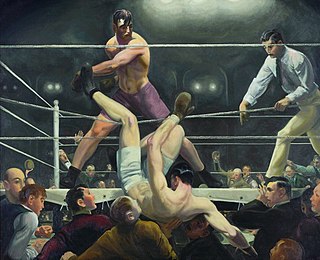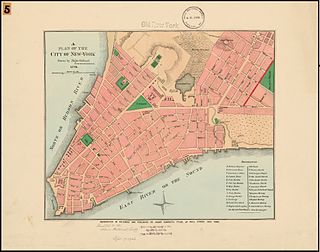
Jacob August Riis was a Danish-American social reformer, "muckraking" journalist, and social documentary photographer. He contributed significantly to the cause of urban reform in the United States of America at the turn of the twentieth century. He is known for using his photographic and journalistic talents to help the impoverished in New York City; those impoverished New Yorkers were the subject of most of his prolific writings and photography. He endorsed the implementation of "model tenements" in New York with the help of humanitarian Lawrence Veiller. He was an early proponent of the newly practicable casual photography and one of the first to adopt photographic flash. While living in New York, Riis experienced poverty and became a police reporter writing about the quality of life in the slums. He attempted to alleviate the poor living conditions of poor people by exposing these conditions to the middle and upper classes.

Five Points was a 19th-century neighborhood in Lower Manhattan, New York City. The neighborhood, partly built on low-lying land which had filled in the freshwater lake known as the Collect Pond, was generally defined as being bound by Centre Street to the west, the Bowery to the east, Canal Street to the north, and Park Row to the south. The Five Points gained international notoriety as a densely populated, disease-ridden, crime-infested slum which existed for over 70 years.

How the Other Half Lives: Studies among the Tenements of New York (1890) is an early publication of photojournalism by Jacob Riis, documenting squalid living conditions in New York City slums in the 1880s. The photographs served as a basis for future "muckraking" journalism by exposing the slums to New York City's upper and middle classes. They inspired many reforms of working-class housing, both immediately after publication as well as making a lasting impact in today's society.

A tenement is a type of building shared by multiple dwellings, typically with flats or apartments on each floor and with shared entrance stairway access. They are common on the British Isles, particularly in Scotland. In the medieval Old Town, in Edinburgh, tenements were developed with each apartment treated as a separate house, built on top of each other. Over hundreds of years, custom grew to become law concerning maintenance and repairs, as first formally discussed in Stair's 1681 writings on Scots property law. In Scotland, these are now governed by the Tenements Act, which replaced the old Law of the Tenement and created a new system of common ownership and procedures concerning repairs and maintenance of tenements. Tenements with one- or two-room flats provided popular rented accommodation for workers, but in some inner-city areas, overcrowding and maintenance problems led to shanty towns, which have been cleared and redeveloped. In more affluent areas, tenement flats form spacious privately owned houses, some with up to six bedrooms, which continue to be desirable properties.

Mulberry Street is a principal thoroughfare in Lower Manhattan, New York City, United States. It is historically associated with Italian-American culture and history, and in the late 19th and early 20th centuries was the heart of Manhattan's Little Italy.
The New York State Tenement House Act of 1901 banned the construction of dark, poorly ventilated tenement buildings in the U.S. state of New York. Among other sanctions, the law required that new buildings must be built with outward-facing windows in every room, an open courtyard, proper ventilation systems, indoor toilets, and fire safeguards. One of the reforms of the Progressive Era, it was one of the first laws of its kind in the U.S.
Documentary photography usually refers to a popular form of photography used to chronicle events or environments both significant and relevant to history and historical events as well as everyday life. It is typically undertaken as professional photojournalism, or real life reportage, but it may also be an amateur, artistic, or academic pursuit.

The People of the Abyss (1903) is a book by Jack London, containing his first-hand account of several weeks spent living in the Whitechapel district of the East End of London in 1902. London attempted to understand the working-class of this deprived area of the city, sleeping in workhouses or on the streets, and staying as a lodger with a poor family. The conditions he experienced and wrote about were the same as those endured by an estimated 500,000 of the contemporary London poor.

American Realism was a style in art, music and literature that depicted contemporary social realities and the lives and everyday activities of ordinary people. The movement began in literature in the mid-19th century, and became an important tendency in visual art in the early 20th century. Whether a cultural portrayal or a scenic view of downtown New York City, American realist works attempted to define what was real.
Reverend Louis or Lewis Morris Pease was an American Methodist clergyman, educator and prominent reformer during the mid-to late 19th century. He founded the Five Points Mission and later the Five Points House of Industry, established in New York City's infamous Five Points district, which provided religious teaching and work for the area's predominantly working-class Irish Catholics.

How the Other Half Dies: The Real Reasons for World Hunger is a book by Franco-American activist Susan George, a member of the Transnational Institute. It was originally published in 1976, not long after the World Food Conference, and has been reprinted several times since.
Social documentary photography or concerned photography is the recording of what the world looks like, with a social and/or environmental focus. It is a form of documentary photography, with the aim to draw the public's attention to ongoing social issues. It may also refer to a socially critical genre of photography dedicated to showing the life of underprivileged or disadvantaged people.

Mulberry Bend was an area surrounding a curve on Mulberry Street, in the Five Points neighborhood in Lower Manhattan, New York City. It is located in what is now Chinatown in Manhattan.

Alfred Tredway White was an American housing reformer and philanthropist, and was known as "Brooklyn's first citizen." After attending Rensselaer Polytechnic Institute, he developed the Home Buildings (1877), Tower Buildings and the Riverside Buildings (1890). He advocated a model of "philanthropy plus five percent," accepting a limited financial return on his projects.

Columbus Park formerly known as Mulberry Bend Park, Five Points Park and Paradise Park, is a public park in Chinatown, Manhattan, in New York City that was built in 1897.

The Trench in Potter's Field is a black and white photograph produced by Danish-American photographer Jacob A. Riis, probably in 1890, depicting a trench used as a mass grave for tenement residents who died during the period of mass immigration in New York. This photograph was part of the larger work made by Riis to depict the conditions of the lower classes of New York in his photographic and journalistic work.

Eldridge Street is a street in the Lower East Side and Chinatown neighborhoods of Manhattan in New York City, running from Houston Street in the north to East Broadway in the south. Originally called Third Street according to the numbering system for the Delancey Farm Grid, it was named in 1817 for Lt. Joseph C. Eldridge, whose unit was ambushed by Indian allies of the British in Upper Canada during the War of 1812.

Bandits' Roost, 59 1/2 Mulberry Street is a black and white photograph produced by Danish-American photojournalist and social reformer Jacob Riis in 1888. The photograph was possibly not taken by Riis but instead by one of his assistant photographers, Henry G. Piffard or Richard Hoe Lawrence. It was first published in the photographic book How the Other Half Lives, in 1889, which aimed to document the social conditions of the poorest people of New York.

Lodgers in Bayard Street Tenement, Five Cents a Spot is a black and white photograph taken by Danish-American photographer Jacob Riis, in 1889. It was included in his photographic book How the Other Half Lives, published in 1890.

Sabbath Eve in a Coal Cellar, Ludlow Street is a black and white photograph taken by Danish American photographer Jacob Riis, probably c. 1890.















